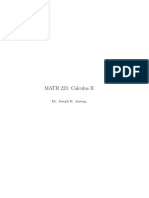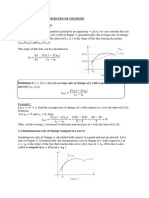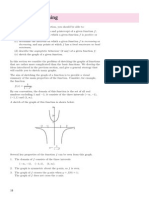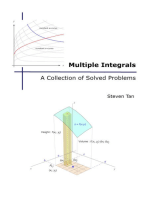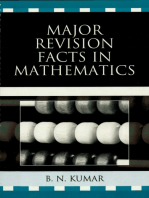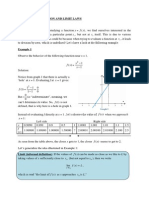Chapter 3-Applications of Differentiation
Uploaded by
diktatorimhotep8800Chapter 3-Applications of Differentiation
Uploaded by
diktatorimhotep8800PCL0016 CALCULUS
Topic 3
Applications of Derivatives
Note: These notes have been adopted form the given text book (Anton, Bivens Davis.
Calculus Early Transcendental, Tenthe Edition. Wiley). This includes figures, examples,
definitions, theorems and clarifications.
Faculty of Engineering
(FOE)
PCL0016 Topic 3
1
TOPIC 3: APPLICATIONS OF DERIVATIVES
Objectives:
To be able to understand the concept and solve the problems of the followings:
1. Analysis of Functions.
2. Extreme Values of Functions
3. First and Second Derivative Test.
4. Concavity and Curve Sketching.
5. Optimization Problems.
6. Rectilinear Motion.
Contents
3.1 Analysis of Functions I: Increase, Decrease, and Concavity ................................... 2
3.1.1 Increasing and Decreasing Functions ............................................................... 2
3.1.2 Concavity .......................................................................................................... 4
3.1.3 The Second Derivative Test for Concavity ...................................................... 5
3.1.4 Inflection Points ................................................................................................ 5
3.2 Analysis of Functions II: Relative Extrema, Graphing Polynomials ....................... 7
3.2.1 Relative Maxima and Minima ......................................................................... 7
3.2.1.1 Finding Extrema.............................................................................................. 8
3.2.2 Analysis of Polynomials ................................................................................. 10
3.3 Analysis of Functions III: Rational Functions, Cusps, and Vertical tangents ....... 10
3.3.1 Properties of Graphs ....................................................................................... 10
3.3.2 Graphing Rational Functions .......................................................................... 10
3.3.3 Graphing Vertical Tangents and Cusps .......................................................... 13
3.4 Absolute Maxima and Minima .............................................................................. 15
3.4.1 Absolute Extrema ........................................................................................... 15
3.4.2 A Procedure for Finding the Absolute Extrema of a Continuous Function f on
a Finite Closed Interval [a, b] ......................................................................... 15
3.5 Applied Maximum and Minimum Problems ......................................................... 16
3.5.1 Problems (Optimization) Involving Finite Closed Intervals .......................... 16
3.5.2 Steps in Solving Optimization Problems: ....................................................... 16
3.6 Rectilinear Motion ................................................................................................. 17
3.6.1 Velocity and Speed ......................................................................................... 17
3.6.2 Acceleration .................................................................................................... 18
3.6.3 Speeding Up and Slowing Down .................................................................... 19
PCL0016 Topic 3
2
3.1 Analysis of Functions I: Increase, Decrease, and Concavity
The main purpose of this section is to develop mathematical tools that can be used to
determine the exact shape of a graph and the precise locations of its key features.
3.1.1 Increasing and Decreasing Functions
The terms increasing, decreasing and constant are used to describe the behavior of a
function as we travel left to right along its graph. For example, the function graphed in
Figure 3.1.1 can be described as increasing to the left of 0 = x , decreasing from 0 = x to
2 = x , increasing from 2 = x to 4 = x , and constant to the right of 4 = x .
Figure 3.1.1
Note: The definitions of increasing, decreasing and constant describe the behavior
of a function on an interval and not at a point. In particular, it is not inconsistent to say
that the function in figure 3.1.1 is decreasing on the interval [0, 2] and increasing on the
interval [2, 4].
The following definition, which is illustrated in Figure 3.1.2, expresses these intuitive
ideas precisely.
Definition 3.1.1: Let f be defined on an interval, and let
2 1
and x x denote points in that
interval.
(i) f is increasing on the interval if ) ( ) (
2 1
x f x f < whenever . x x
2 1
<
(ii) f is decreasing on the interval if ) ( ) (
2 1
x f x f > whenever . x x
2 1
<
(iii) f is constant on the interval if ) ( ) (
2 1
x f x f = for all points . x x
2 1
and
Figure 3.1.2
Constant
x
Increasing Increasing Decreasing
0 2 4
PCL0016 Topic 3
3
Figure 3.1.3 suggests that a differentiable function f is increasing on any interval where
each tangent line to its graph has positive slope, is decreasing on any interval where each
tangent line to its graph has negative slope, and is constant on any interval where each
tangent line to its graph has zero slope. This intuitive observation suggests the following
important theorem.
Figure 3.1.3
Theorem 1: Let f be a function that is continuous on a closed interval [a, b] and
differentiable on the open interval (a, b).
(i) If 0 ) (
1
> ' x f for every value of x in (a, b), then f is increasing on [a, b].
(ii) If 0 ) (
1
< ' x f for every value of x in (a, b), then f is decreasing on [a, b].
(iii)If 0 ) (
1
= ' x f for every value of x in (a, b), then f is constant on [a, b].
Note2: The above Theorem is applicable on any interval on which f is continuous. For
example, if f is continuous on ) [ + , a and 0 ) ( > ' x f on ) ( + , a , then f is increasing on
) [ + , a ; and if f is continuous on ) ( + , and 0 ) ( < ' x f on ) ( + , , then f is
decreasing on ) ( + , .
Example 3.1
Find the intervals on which 3 4 ) (
2
+ = x x x f is increasing and the intervals on which it
is decreasing.
Solutions: the graph of f in Figure 3.1.4 suggests that f is decreasing for 2 s x and
increasing for 2 > x . To confirm this, we analyze the sign of f ' (derivative of f)
) 2 ( 2 4 2 ) ( = = ' x x x f
It follows that
. x x f
. x x f
< > '
< < '
2 if 0, ) (
2 if 0, ) (
Since f is continuous everywhere, it follows from the Note-2, that
) 2 [ on increasing is
2] , (- on decreasing is
+
, f
f
Each tangent line has
negative slope.
y
x
Each tangent line has
positive slope.
y
x
Each tangent line has
zero slop.
y
x
PCL0016 Topic 3
4
Figure 3.1.4
3.1.2 Concavity
Definition 3.1.2: if f is differentiable on an open interval, then f is said to be concave
up on the open interval if f ' is increasing on that interval, and f is said to be concave
down on the open interval if f ' is decreasing on that interval. In another words, The
graph of a differentiable function y = f(x) is
1- Concave upward on the open interval if
'
f is increasing.
2- Concave downward on the open interval if
'
f is decreasing.
Note: on intervals where the graph of f has upward curvature we say that f is concave
up, and on intervals where the graph has downward curvature we say that f is concave
down.
Figure 3.1.5 suggests two ways to characterize the concavity of a differentiable function
f on an open interval:
1- f is concave up on an open interval if its tangent lines have increasing slopes on
that interval and is concave down if they have decreasing slopes.
2- f is concave up on an open interval if it graph lies above its tangent lines on that
interval and is concave down if it lies below its tangent lines.
Figure 3.1.5
2
3
-1
x
y
PCL0016 Topic 3
5
3.1.3 The Second Derivative Test for Concavity
Theorem 2: Let y = f(x) be twice differentiable on an open interval.
1. If 0 ) ( > ' ' x f for every value of x in the open interval, then the graph of f is
concave up on that interval.
2. If 0 ) ( < ' ' x f for all x in the open interval, then the graph of f is concave
downward on that interval.
Example 3.2
Determine the concavity of 3 4 ) (
2
+ = x x x f .
Solutions: Figure 3.1.4 in example 1 suggests that the function 3 4 ) (
2
+ = x x x f is
concave up on the interval ( + , ). This is consistent with Theorem 2, for the
following reasons:
1- The first derivative: 4 2 ) ( = ' x x f
2- The second derivative: 2 ) ( = ' ' x f , so
0 ) ( > ' ' x f on the interval ( + , )
3.1.4 Inflection Points
Point where a curve changes from concave up to concave down or vice versa are of
special interest, so there is some terminology associated with them.
Definition 3.1.3: if f is continuous on an open interval containing a value
0
x , and if f
changes the direction of its concavity at the point )), ( (
0 0
x f , x then we say that f has an
inflection point at
0
x , and we call the point )), ( (
0 0
x f , x on the graph of f an inflection
point of f (Figure 3.1.6)
Figure 3.1.6
PCL0016 Topic 3
6
Example 3.3
Use the first and second derivatives of 1 3 ) (
2 3
+ = x x x f to determine the intervals on
which f is increasing, decreasing, concave up, and concave down and identify any point
of inflection of f(x).
Solution:
Calculation the first tow derivatives of f we obtain
) 2 ( 3 6 3 ) (
2
= = ' x x x x x f , ) 1 ( 6 6 6 ) ( = = ' ' x x x f
The sign analysis of these derivatives is shown in the following tables:
Figure 3.1.7
Interval
) 2 ( 3 x x ) (x f '
Conclusion
x<o
(-)(-) +
f is increasing on (- 0 , ]
0<x<2 (+)(-)
-
f is decreasing on [0, 2]
x>2 (+)(+) + f is increasing on [2, + )
Interval
) 1 ( 6 x x ) (x f ' '
Conclusion
x<1
(-) -
f is concave down on (- 1 , )
x>1 (+)
+ f is concave up on (- + , 1 )
The second table shows that there is an inflection point at x=1, since f changes from
concave down to concave up at that point. The inflection point is (1, f(1)) = (1, -1).
Exercise: Find (if any) the inflection point for the following functions.
3
) ( x x f = (has an inflection point at x = 0).
1 3 ) (
2 3
+ = x x x f (has an inflection point at x = 1).
3 4 ) (
2
+ = x x x f (has no inflection points).
2
-1
x
y
-3
-
-
-
-
1 3
. (1, -1)
PCL0016 Topic 3
7
3.2 Analysis of Functions II: Relative Extrema, Graphing Polynomials
In this section we will develop methods for finding the high and low points on the graph
of a function and we will discuss procedures for analyzing the graphs of polynomials.
3.2.1 Relative Maxima and Minima
Definition 3.2.1: A function f is said to have a relative maximum at
0
x if there is an
open interval containing
0
x on which ) (
0
x f is the largest value, that is, ) ( ) (
0
x f x f >
for all x in the interval. Similarly, f is said to have a relative minimum at
0
x if there is
an open interval containing
0
x on which ) (
0
x f is the smallest value, that is,
) ( ) (
0
x f x f s for all x in the interval. If f has either a relative maximum or a relative
minimum at
0
x , then f is said to have a relative extremum at
0
x
Notes: A relative maximum need not be the highest point in the entire range, and a
relative minimum not be the lowest point (they are just high and low points relative to the
nearby terrain as shown in Figure 3.2.1
Figure 3.2.1
1
How to identify types of maxima and minima for a function with domain
b a x s s
Exercise
Find (if any) the relative minimum and relative minimum for the following functions
1.
2
) ( x x f =
has a relative minimum at x = 0 but no relative maxima.
2.
3
) ( x x f =
has no relative extrema.
3. 3 3 ) (
3
+ = x x x f
has relative minima at x = -1, and a relative minimum at
x = 1.
4. 1 4 ) (
2 3
3
4
4
2
1
+ + = x x x x x f
has relative minima at x = -1, and x = 2, and
a relative maximum at x = 1.
5. x cos x f = ) (
has relative maxima at all even multiples of t and relative
minima at all odd multiples of t .
1
Figure 3.2.1 has been adopted from Thomas Calculus, Twelfth Edition, Maurice D. Weir, and Joel Hass.
PCL0016 Topic 3
8
3.2.1.1 Finding Extrema
Definition 3.2.2:
- We define a critical point for a function f to be a point in the domain of f at which
either the graph of f has a horizontal tangent line or f is not differentiable.
- We call x a stationary point of f if f(x) = 0.
Theorem 3: suppose that f is a function defined on an open interval containing the point
0
x . If f has a relative extremum at x =
0
x , then x =
0
x is a critical point of f; that is,
either 0 ) (
0
= ' x f or f is not differentiable at
0
x .
Example 3.5
Find all critical points of 3 3 ) (
3
+ = x x x f .
Solution:
The function f, being a polynomial, is differentiable everywhere, so its critical points are
all stationary points. To find these points we must solve the equation 0 ) ( = ' x f .
) 1 )( 1 ( 3 3 3 ) (
2
+ = = ' x x x x f
We conclude that the critical points occur at x = -1 and x = 1 as shown in Figure 3.2.2
Figure 3.2.2
Theorem 4 (Finding Extrema: First Derivative Test)
Suppose that f is continuous at a critical point
0
x .
(i) If 0 ) (
0
> ' x f on an open interval extending left from
0
x and 0 ) (
0
< ' x f on an open
interval extending right from
0
x , then f has a relative maximum at
0
x .
(ii) If 0 ) (
0
< ' x f on an open interval extending left from
0
x and 0 ) (
0
> ' x f on an open
interval extending right from
0
x , then f has a relative minimum at
0
x .
(iii) If ) (
0
x f ' has the same sign on an open interval extending left from
0
x as it does on
an open interval extending right from
0
x , then f does not have a relative extremum
at
0
x .
We can also apply Second Derivative Test to identify extrema: A function f has a relative
maximum at a stationary point if the graph of f is concave down on an open interval
PCL0016 Topic 3
9
containing that point, and it has a relative minimum if it is concave up as shown in Figure
3.2.3
Figure 3.2.3
Theorem 5 (Finding Extrema: Second Derivative Test)
Suppose that f is twice differentiable at the point
0
x .
(i) If 0 ) (
0
= ' x f and 0 ) (
0
> ' ' x f , then f has a relative minimum at
0
x .
(ii) If 0 ) (
0
= ' x f and 0 ) (
0
< ' ' x f , then f has a relative maximum at
0
x .
(iii) If 0 ) (
0
= ' x f and 0 ) (
0
= ' ' x f , then the test is inconclusive; that is, f may have a
relative maximum, a relative minimum, or neither at
0
x .
Example 3.6
Find the relative extrema of . x x x f
3 5
5 3 ) ( =
Solution: We have
) 1 )( 1 ( 15 ) 1 ( 15 15 15 ) (
2 2 2 2 4
+ = = = ' x x x x x x x x f
) 1 (2 30 30 60 ) (
2 3
= = ' ' x x x x x f
Solving 0 ) ( = ' x f yields the stationary point -1. 1, 0 = = = x x , x As shown in the
following table, we can conclude from the second derivative test that f has a relative
maximum at 1 = x and relative minimum at 1 = x .
Stationary Point
) 1 (2 30
2
x x
) (x f ' ' Second Derivative Test
x = -1 -30 - f has a relative maximum
x = 0 0 0 Inconclusive
x = 1 30 + f has a relative minimum
The test is inconclusive at x = 0, se we will try the first derivative test at that point. A sign
analysis of f ' is given in the following table:
Interval
1) - )( 1 ( 15
2
x x x +
) (x f '
0 1 < < x (+)(+)(-)
-
1 0 < < x (+)(+)(-) -
PCL0016 Topic 3
10
Since there is no sign change in ) (x f ' at x=0, there is neither a relative maximum nor a
relative minimum at that point. All of this is consistent with the graph of f shown in
Figure 3.2.4.
3.2.2 Analysis of Polynomials
Polynomials are among the simplest functions to graph and analyze. Their significant
features are symmetry, intercepts, relative extrema, inflection points, and the behavior as
+ x and
x
Exercise:
Sketch the graph of the equation 2 3
3
+ = x x y
and identify the locations of the
intercepts, relative extrema, and inflection points.
3.3 Analysis of Functions III: Rational Functions, Cusps, and Vertical tangents
In this section we will discuss procedures for graphing rational functions and other kinds
of curves.
3.3.1 Properties of Graphs
In many problems, the properties of interest in the graph of a function are: (Symmetries,
Periodicity, x-intercepts, y-intercepts, Relative extrema, Concavity, Intervals of increase
and decrease, Inflection points, Asymptotes, Behavior as , x + and x ).
Note: Some of these properties may not be relevant in certain cases; for example,
asymptotes are characteristic of rational functions but not of polynomials, and periodicity
is characteristic of trigonometric functions but not of polynomial or rational functions.
3.3.2 Graphing Rational Functions
Definition 3.3.1: A rational function is a function of the form ) ( ) ( x Q / x P ) x ( f = in
which P(x) and Q(x) are polynomials.
Note: if P(x) and Q(x) have no common factors, then the information obtained in the
following steps will usually be sufficient to obtain an accurate sketch of the graph of a
rational function.
2
-1
x
y
-2
-
-
-
1 2 -1
3 5
5 3 x x y =
PCL0016 Topic 3
11
Table.1 How to Sketch the Graph of a Rational Function
Example 3.7: Sketch a graph of the equation
16
8 2
2
2
=
x
x
y
And identify the locations of the intercepts, relative extrema, inflection points, and
asymptotes.
Solution:
Since the numerator and denominator have no common factors, so we will follow the
procedure in table 1.
- Symmetries: replacing x by x does not change the equation, so the graph is
symmetric about the y-axis.
- x- and y-intercepts: setting y = 0 yields the x-intercepts x = -2 and x = 2. Setting x = 0
yields the y-intercept y = .
2
1
- Vertical asymptotes: we observed above that the numerator and denominator of y
have no common factors, so the graph has vertical asymptotes at the points where the
denominator of y is zero, namely, at x = -4 and x = 4.
- Sign of y: the set of points where x-intercepts or vertical asymptotes occur is
{-4, -2, 2, 4}. These points divide the x-axis into the open intervals
) (4, 4), (2, 2), (-2, 2), - 4 ( 4), - ( + , ,
We can find the sign of y on each interval by choosing an arbitrary test point in the
interval and evaluating y = f(x) at the test point as shown in table 2.
PCL0016 Topic 3
12
Interval Test point Value of y Sign of y
4) - ( , -5 14/3 +
2) - 4 ( , -3 -10/7 -
2) (-2, 0 +
4) (2, 3 -10/7 -
) (4, + 5 14/3 +
Table 2 Sign analysis of example 3.8
- End behavior: The limits
2
2
) 16 ( 1
) 8 ( 2
16
8 2
) 16 ( 1
) 8 ( 2
16
8 2
2
2
2
2
2
2
2
2
= =
= =
+
x /
x /
x
x
x
x
x /
x /
x
x
x
x
lim lim
lim lim
This yield the horizontal asymptote y = 2.
- Derivatives:
3 2
2
2
2
2 2 2 2
2 2
) 16 (
) 3 16 ( 48
16) - (
48
) 16 (
) 2 )( 8 2 ( ) 4 )( 16 (
+
=
=
=
x
x
dx
y d
x
x
x
x x x x
dx
dy
Conclusions and graph:
- The sign analysis of y (as shown in Figure 3.3.1a) reveals the behavior of the graph in
the vicinity of the vertical asymptotes: the graph increases without bound as
(
4 x ) and decreases without bound as (
+
4 x ); and the graph decreases
without bound as (
4 x ) and increases without bound as (
+
4 x ) as shown in
Figure 3.3.1b
- The sign analysis of dy/dx in Figure shows that the graph is increasing to the left of
x = 0 and is decreasing to the right of x = 0. Thus, there is a relative maximum at the
stationary point x = 0. There are no relative minima.
- The sign analysis of (
2
2
dx
y d
) in Figure 3.3.1a shows that the graph is concave up to the
left of x = -4, is concave down between x = -4 and x = 4, and is concave up to the
right of x = 4. There are no inflection points.
Figure 3.3.1 a
x
0 0
+ + +
+ + + - + + + - - -
2
0
4 -4 -2
Sign of y
+ + + - + + + - -
4 -4
Sing of
2 2
dx / y d
- - - -
Concave up Concave down Concave up
x
0
x
+ + + - + + + -
0
4 -4
Sign of dy/dx
- - - - - -
0
Decr. Decr. Incr. Incr.
PCL0016 Topic 3
13
Exercise: Sketch the complete graph of
16
8 2
2
2
=
x
x
y
3.3.3 Graphing Vertical Tangents and Cusps
Figure 3.3.2 shows four curve elements that are commonly found in graphs of functions
that involve radicals or fractional exponents. In all four cases the function is not
differentiable at
0
x because the secant line through (
0
x , f(
0
x )) and (x, f(x)) approaches a
vertical position as x approaches
0
x from either side. Thus, in each case, the curve has a
vertical tangent line at (
0
x , f(
0
x )). In parts (a) and (b) of the figure, there is an inflection
point at
0
x because there is a change in concavity at that point. In part (c) and (d), where
f(x) approaches + from one side of xo and from the other side, we say that the
graph has a cusp at
0
x .
Figure 3.3.2
Example 3.8 Sketch the graph of
3 4 3 1
3 6
/ /
x x y + =
Solution
Rewrite the given function
) 2 ( 3 3 6
3 1 3 4 3 1
x x x x y
/ / /
+ = + =
- Symmetries: there are no symmetries about the coordinate axes of the origin (verify).
- x- and y-intercepts: setting ) 2 ( 3
3 1
x x y
/
+ = yields the x-intercepts x = 0 and x = -2.
Setting x = 0 yields the y-intercepts y = 0.
- Vertical asymptotes: none, since
3 4 3 1
3 6 ) (
/ /
x x x f + = is continuous everywhere.
x
4 -4
y
Figure 3.3.1 b
PCL0016 Topic 3
14
- End behavior: the graph has no horizontal asymptotes since
+ = + = +
+ = + = +
+ +
) 2 ( 3 3 6
) 2 ( 3 3 6
3 1 3 4 3 1
3 1 3 4 3 1
x x lim x x lim
x x lim x x lim
/
x
/ /
x
/
x
/ /
x
- Derivatives:
3 5
3 5
3
4
3 2
3
4
3 5
3
4
2
2
3 2
3 2 3 1 3 2
3
) 1 ( 4
) 1 (
) 1 2 ( 2
) 2 1 ( 2 4 2 ) (
/
/ / /
/
/ / /
x
x
x x x x ) x ( f
dx
y d
x
x
x x x x x f
dx
dy
= + = + = ' ' =
+
= + = + = ' =
- Vertical tangent lines: there is a vertical tangent line at x = 0 since f is continuous
there and
+ =
+
= '
+ =
+
= '
+ +
3 2
0 0
3 2
0 0
) 1 2 ( 2
) (
) 1 2 ( 2
) (
/
x x
/
x x
x
x
lim x f lim
x
x
lim x f lim
Conclusions and graph:
- From the sign analysis of y in Figure 3.3.2a, the graph is below the x-axis between the
x-intercepts x = -2 and x = 0 and is above the x-axis if x < -2 or x > 0.
- From the formula for dy/dx we see that there is a stationary point at x = -1/2 and a
critical point at x = 0 at which f is not differentiable. We saw above that a vertical
tangent line and inflection point are at that critical point.
- The sign analysis of dy/dx in Figure 3.3.2a and the first derivative test show that there
is a relative minimum at the stationary point at x = -1/2 (verify).
- The sign analysis of d
2
y/dx
2
in Figure 3.3.2a shows that in addition to the inflection
point at the vertical tangent there is an inflection point at x = 1 at which the graph
changes from concave down to concave up.
Figure 3.3.2
PCL0016 Topic 3
15
3.4 Absolute Maxima and Minima
In this section we will be concerned with the more encompassing problem of finding the
larges and smallest values of a function over an interval.
3.4.1 Absolute Extrema
Definition 3.4.1: Consider an interval in the domain of a function f and a point
0
x in
that interval. We say that f has an absolute maximum at
0
x if ) ( ) (
0
x f x f s for all x in
the interval, and we say that f has an absolute minimum at
0
x if ) ( ) (
0
x f x f s for all x in
the interval. We say that f has an absolute extreme at
0
x if it has either an absolute
maximum or an absolute minimum at that point.
Notes:
1. If f has an absolute maximum at the point
0
x on an interval, then f(
0
x ) is the
largest value of f on the interval.
2. If f has an absolute minimum at
0
x , then f(
0
x ) is the smallest value of f on the
interval.
3. In general, there is no guarantee that a function will actually have an absolute
maximum or minimum on a given interval as shown in Figure 3.4.1.
Figure 3.4.1
Parts (a) - (d) of Figure 3.4.1 show that a continuous function may or may not have
absolute maxima or minima on an infinite interval or on a finite open interval.
Theorem 7(Extreme-Value Theorem): if a function f is continuous on a finite closed
interval [a, b], then f has both an absolute maximum and an absolute minimum on [a, b].
(see part (e) of Figure 3.4.1).
3.4.2 A Procedure for Finding the Absolute Extrema of a Continuous Function f
on a Finite Closed Interval [a, b]
Step 1. Find the critical points of f in ) , ( b a .
Step 2. Evaluate f at the critical points of f and at the endpoints a, and b.
Step 3. The largest of the values in Step 2 is the absolute maximum value of f on [a, b],
and the smallest value is the absolute minimum.
PCL0016 Topic 3
16
Example 3.9
Find the absolute maximum and minimum values of
4
8 ) ( x x x f = on the interval [0, 3],
and determine where these values occur.
Solution:
The extreme values occur either at the endpoints or at the critical points.
To find the critical point, solve 0 ) ( = ' x f .
3
4 8 ) ( x x f = '
3
2 0 ) ( = = ' x x f
The critical point is x =
3
2
Evaluating f at the endpoints and the critical points yields
6 7 ) 2 ( 57 ) 3 ( 0 ) 0 (
3
. f , f , f ~ = =
The absolute minimum of f is -57.
The absolute maximum of f is 7.6.
3.5 Applied Maximum and Minimum Problems
In this section we will show how the methods discussed in the last section can be used to
solve various applied optimization problems.
3.5.1 Problems (Optimization) Involving Finite Closed Intervals
Definition 3.5.1: Problems that reduce to maximizing or minimizing a continuous
function over a finite closed interval.
For problem of this type the Extreme-Value Theorem (Theorem 7) guarantees that the
problem has a solution, and we know that the solution can be obtained by examining the
values of the function at the critical points and at the endpoints.
3.5.2 Steps in Solving Optimization Problems:
1. Understand the problem.
2. Draw an appropriate figure and label the quantities (variables) relevant to the
problem.
3. Assign a symbol to the quantity that is to be maximized or minimized and to the
relevant variables. Find a formula (or formulas) to relate the variables.
4. Using the conditions stated in the problem to eliminate variables, express the
quantity to be maximized or minimized as a function of one variable.
5. Find the interval of possible values, if any, for this variable from the physical
restrictions in the problem.
6. Use the techniques of the preceding section to obtain the absolute maximum or
minimum value.
PCL0016 Topic 3
17
3.6 Rectilinear Motion
One of the important themes in calculus is the study of motion. To describe the motion of
an object completely, one must specify its speed (how fast it is going) and the direction in
which it is moving. The speed and the direction of motion together comprise what is
called the velocity of the object. Some examples are a piston moving up and down in a
cylinder, a race car moving along a straight track , an object dropped from the top of a
building and falling straight down, a ball thrown straight up and then falling down along
the same line, and so forth.
In this section we will consider a simple application in physics: motion along a line; this
is called rectilinear motion. We will define the notion of acceleration mathematically,
and we will show how the tools of calculus developed earlier in this chapter can be used
to analyze rectilinear motion.
Notes:
1. For computational purposes, we will assume that a particle in rectilinear motion
moves along a coordinate line, which we will call the s-axis.
2. A graphical description of rectilinear motion along an s-axis can be obtained by
making a plot of the s-coordinate of the particle versus the elapsed time t from
starting time t = 0. This is called the position versus time curvefor the particle.
3. As the particle moves along the s-axis, its coordinate s will be some function of
time, say s = s(t). We call s(t) the position function of the particle.
4. If the coordinate of a particle at time
1
t is s(
1
t ) and the coordinate at a later time
2
t is s(
2
t ), then s(
2
t ) - s(
1
t ) is called the displacement of the particle over the
time interval [
1
t ,
2
t ]. The displacement describes the change is position of the
particle.
3.6.1 Velocity and Speed
Definition 3.6.1: the instantaneous velocity of a particle in rectilinear motion is the
derivative of the position function. Thus, if a particle in rectilinear motion has position
function s(t), then we define its velocity function v(t) to be
dt
ds
t s t v = ' = ) ( ) ( .(3.6.1)
Notes: The sign of the velocity tells which way the particle is moving:
- A positive value for v(t) means that s is increasing with time, so the particle is moving
in the positive direction.
- A negative value for v(t) means that s is decreasing with time, so the particle is
moving in the negative direction.
- If v(t) = 0, then the particle has momentarily stopped.
For a particle in rectilinear motion it is important to distinguish between its velocity,
which describes how fast and in what direction the particle is moving, and its speed,
which describes only how fast the particle is moving. We make this distinction by
defining speed to be the absolute value of velocity. Thus a particle with a velocity of
PCL0016 Topic 3
18
2 m/s has a speed of 2 m/s and is moving in the positive direction, while a particle with a
velocity of -2 m/s also has speed of 2 m/s but is moving in the negative direction.
Since the instantaneous speed of a particle is the absolute value of its instantaneous
velocity, we define its speed function to be
dt
ds
t s t v = ' = ) ( ) ( .(3.6.2)
The speed function, which is always nonnegative, tells us how fast the particle is moving
but not its direction of motion.
Example 3.10
Let
2 3
6 ) ( t t t s = be the position function of a particle moving along and s-axis, where s
is in meters and t is in seconds. Find the velocity and speed functions and show/discuss
the graphs of position, velocity, and speed versus time.
Solution
From (3.6.1) and (3.6.2), the velocity and speed functions are given by
t t
dt
ds
t v 12 3 ) (
2
= = and t t t v 12 3 ) (
2
=
The graphs of position, velocity, and speed versus time are shown in Figure 3.6.1.
Discussion
- The position versus time curve tells us that the particle is on the negative side of the
origin for 0< t <6, is on the positive side of the origin for t > 6, and is at the origin at
times t = 0 and t = 6.
- The velocity versus time curve tells us that the particle is moving in the negative
direction if 0 < t <4, is moving in the positive direction if t > 4, and is momentarily
stopped at times t = 0 and t = 4 (the velocity is zero at those times).
- The speed versus time curve tells us that the speed of the particle is increasing for
0 < t <2, decreasing for 2 < t < 4, and increasing again for t > 4.
Figure 3.6.1
3.6.2 Acceleration
In rectilinear motion, the rate at which the instantaneous velocity of a particle changes
with time is called its instantaneous acceleration. Thus, if a particle in rectilinear motion
has velocity function v(t), then we define its acceleration function to be
PCL0016 Topic 3
19
dt
dv
t v t a = ' = ) ( ) ( .3.6.3
Alternatively, we can use the fact that v(t) = ) (t s' to express the acceleration function in
terms of the position function as
2
2
) ( ) (
dt
s d
t s t a = ' ' = 3.6.4
3.6.3 Speeding Up and Slowing Down
Interpreting the sign of Acceleration: A particle in rectilinear motion is speeding up
when its velocity and acceleration have the same sign and slowing down when they have
opposite signs
Example 3.11
Use the curves (velocity versus time and the acceleration versus time curve) in example
3.11to determine when the particle is speeding up and slowing down.
Solution:
- Over the time interval 0 < t < 2 the velocity and acceleration are negative, so the
particle is speeding up this is consistent with the speed versus time curve, since the
speed is increasing over this time interval.
- Over the time interval 2 < t < 4 the velocity is negative and the acceleration is
positive, so the particle is slowing down. This is also consistent with the speed versus
time curve, since the speed is decreasing over this time interval.
- Finally, on the time interval t > 4 the velocity and acceleration are positive, so the
particle is speeding up, which again is consistent with the speed versus time curve.
----------------------------------------------End of Topic 3--------------------------------------------
You might also like
- Guide & Workbook: It'S Worth The EnergyNo ratings yetGuide & Workbook: It'S Worth The Energy13 pages
- XXXX XXXX 6322: XXXX XXXX 6322 XXXX XXXX 6322No ratings yetXXXX XXXX 6322: XXXX XXXX 6322 XXXX XXXX 63221 page
- Application of Digital Signal Processing in Radar: A StudyNo ratings yetApplication of Digital Signal Processing in Radar: A Study4 pages
- MAT060.Chapter 4 Applications of The Derivatives PDFNo ratings yetMAT060.Chapter 4 Applications of The Derivatives PDF30 pages
- Lesson 19_Increasing & Decreasing functionsNo ratings yetLesson 19_Increasing & Decreasing functions56 pages
- Hand Out of Mathematics (TKF 201) : Diferensial & IntegralNo ratings yetHand Out of Mathematics (TKF 201) : Diferensial & Integral13 pages
- Increasing and Decreasing Functions, Concavity and Inflection PointsNo ratings yetIncreasing and Decreasing Functions, Concavity and Inflection Points17 pages
- Concavity, Determining Derivatives and Second DerivativesNo ratings yetConcavity, Determining Derivatives and Second Derivatives12 pages
- MATH 223: Calculus II: Dr. Joseph K. AnsongNo ratings yetMATH 223: Calculus II: Dr. Joseph K. Ansong38 pages
- Part III BSCCAL2 Module 1 Limits and Continuity 2No ratings yetPart III BSCCAL2 Module 1 Limits and Continuity 29 pages
- Mat04 Calculu: Gilbert R. Esquillo, PmeNo ratings yetMat04 Calculu: Gilbert R. Esquillo, Pme64 pages
- FAEN 101: Algebra: Dr. Joseph K. AnsongNo ratings yetFAEN 101: Algebra: Dr. Joseph K. Ansong20 pages
- Increasing and Decreasing Functions: First Derivative Test Second Derivative Test ConcavityNo ratings yetIncreasing and Decreasing Functions: First Derivative Test Second Derivative Test Concavity17 pages
- Tangent Lines and Rates of Changes 1.1 Average Rate of ChangeNo ratings yetTangent Lines and Rates of Changes 1.1 Average Rate of Change16 pages
- Section 2.4: Limits and Infinity Ii: Learning ObjectivesNo ratings yetSection 2.4: Limits and Infinity Ii: Learning Objectives7 pages
- Numerical Analysis by Dr. Anita Pal Assistant Professor Department of Mathematics National Institute of Technology Durgapur Durgapur-713209No ratings yetNumerical Analysis by Dr. Anita Pal Assistant Professor Department of Mathematics National Institute of Technology Durgapur Durgapur-71320924 pages
- P1 Calculus II Partial Differentiation & Multiple IntegrationNo ratings yetP1 Calculus II Partial Differentiation & Multiple Integration20 pages
- Student Solutions Manual to Accompany Economic Dynamics in Discrete Time, secondeditionFrom EverandStudent Solutions Manual to Accompany Economic Dynamics in Discrete Time, secondedition4.5/5 (2)
- TUTORIAL CHAPTER 8 (Differentiations) : X X X FNo ratings yetTUTORIAL CHAPTER 8 (Differentiations) : X X X F6 pages
- Faculty of Engineering (FOE) : Online NotesNo ratings yetFaculty of Engineering (FOE) : Online Notes14 pages
- Richard S/O Santiago Director of Gelugor District Education OfficeNo ratings yetRichard S/O Santiago Director of Gelugor District Education Office1 page
- How To Use Differentiation To Calculate The Maximum Volume of A BoxNo ratings yetHow To Use Differentiation To Calculate The Maximum Volume of A Box2 pages
- Manual. MOVIDRIVE MDX61B Sensor Based Positioning Via Bus Application. Edition 01 - 2005 FA362000 11313528 - ENNo ratings yetManual. MOVIDRIVE MDX61B Sensor Based Positioning Via Bus Application. Edition 01 - 2005 FA362000 11313528 - EN84 pages
- Hearst Business Ethics Field Procedure 2014No ratings yetHearst Business Ethics Field Procedure 20144 pages
- Development of Electronic Banking in Bangladesh100% (2)Development of Electronic Banking in Bangladesh7 pages
- Sample Technical Report: Measurement and ErrorNo ratings yetSample Technical Report: Measurement and Error10 pages
- Instrumentarium Dental Focus X-Ray Unit - Changing Tube Head InstructionsNo ratings yetInstrumentarium Dental Focus X-Ray Unit - Changing Tube Head Instructions14 pages
- Programming Paradigms: Vitaly ShmatikovNo ratings yetProgramming Paradigms: Vitaly Shmatikov31 pages
- Faculty of Business and Management Universiti Teknologi MaraNo ratings yetFaculty of Business and Management Universiti Teknologi Mara8 pages
- SSRF Bible. Cheatsheet: Try Our New ProductNo ratings yetSSRF Bible. Cheatsheet: Try Our New Product23 pages
- Perbandingan Lampu Induksi LVD Dan Lampu LEDNo ratings yetPerbandingan Lampu Induksi LVD Dan Lampu LED5 pages
- Application of Digital Signal Processing in Radar: A StudyApplication of Digital Signal Processing in Radar: A Study
- MAT060.Chapter 4 Applications of The Derivatives PDFMAT060.Chapter 4 Applications of The Derivatives PDF
- Hand Out of Mathematics (TKF 201) : Diferensial & IntegralHand Out of Mathematics (TKF 201) : Diferensial & Integral
- Increasing and Decreasing Functions, Concavity and Inflection PointsIncreasing and Decreasing Functions, Concavity and Inflection Points
- Concavity, Determining Derivatives and Second DerivativesConcavity, Determining Derivatives and Second Derivatives
- Increasing and Decreasing Functions: First Derivative Test Second Derivative Test ConcavityIncreasing and Decreasing Functions: First Derivative Test Second Derivative Test Concavity
- Tangent Lines and Rates of Changes 1.1 Average Rate of ChangeTangent Lines and Rates of Changes 1.1 Average Rate of Change
- Section 2.4: Limits and Infinity Ii: Learning ObjectivesSection 2.4: Limits and Infinity Ii: Learning Objectives
- Numerical Analysis by Dr. Anita Pal Assistant Professor Department of Mathematics National Institute of Technology Durgapur Durgapur-713209Numerical Analysis by Dr. Anita Pal Assistant Professor Department of Mathematics National Institute of Technology Durgapur Durgapur-713209
- P1 Calculus II Partial Differentiation & Multiple IntegrationP1 Calculus II Partial Differentiation & Multiple Integration
- Student Solutions Manual to Accompany Economic Dynamics in Discrete Time, secondeditionFrom EverandStudent Solutions Manual to Accompany Economic Dynamics in Discrete Time, secondedition
- Multiple Integrals, A Collection of Solved ProblemsFrom EverandMultiple Integrals, A Collection of Solved Problems
- Richard S/O Santiago Director of Gelugor District Education OfficeRichard S/O Santiago Director of Gelugor District Education Office
- How To Use Differentiation To Calculate The Maximum Volume of A BoxHow To Use Differentiation To Calculate The Maximum Volume of A Box
- Manual. MOVIDRIVE MDX61B Sensor Based Positioning Via Bus Application. Edition 01 - 2005 FA362000 11313528 - ENManual. MOVIDRIVE MDX61B Sensor Based Positioning Via Bus Application. Edition 01 - 2005 FA362000 11313528 - EN
- Instrumentarium Dental Focus X-Ray Unit - Changing Tube Head InstructionsInstrumentarium Dental Focus X-Ray Unit - Changing Tube Head Instructions
- Faculty of Business and Management Universiti Teknologi MaraFaculty of Business and Management Universiti Teknologi Mara






















